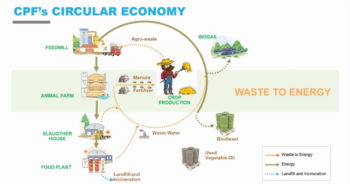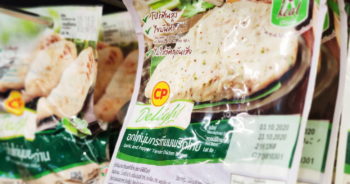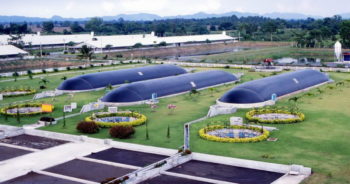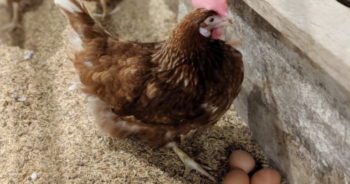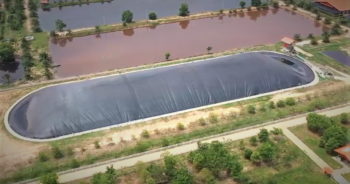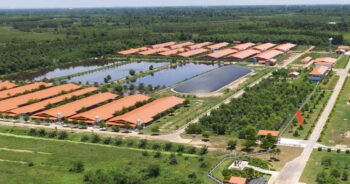โลกกำลังเผชิญกับปัจจัยเสี่ยงด้านสิ่งแวดล้อมและสภาวะโลกร้อนเพิ่มขึ้น ก่อให้เกิดกระแส “อนุรักษ์” และ เรียกร้อง “ความรับผิดชอบ” จากประชาคมโลก ตลอดจนบริษัท ห้าง ร้าน เพื่อรวมพลังกันสร้างโลกในอนาคตให้ “คงอยู่อย่างสมดุลและยั่งยืน” โดยเฉพาะการบริโภคทรัพยากรธรรมชาติที่ใช้แล้วหมดไป เช่น น้ำมัน สินแร่ ป่าไม้ และไม่สามารถก่อเกิดขึ้นใหม่ได้ในเวลาอันรวดเร็ว เราจึงจำเป็นต้องหาวิธีที่จะใช้ทรัพยากรเหล่านี้อย่างคุ้มค่าที่สุดและเกิดประสิทธิภาพสูงสุดแต่เกิดการสูญเสียน้อยที่สุด
โจทย์ของโลกในวันนี้ คือ ทำอย่างไรเพื่อคืนสภาพหรือให้ชีวิตใหม่กับทรัพยากรธรรมชาติที่กำลังจะหมดไป และปัญหาใหญ่ คือ ขยะเมื่อสิ้นสุดการบริโภค โดยเฉพาะขยะพลาสติก “เศรษฐกิจหมุนเวียน” หรือ circular economy คือ การนำมาหมุนเวียนใช้ประโยชน์ให้มากที่สุด เกิดของเสียน้อยที่สุด ซึ่งเป็นแนวทางที่นิยมใช้ในระบบอุตสาหกรรมการผลิต โดยนำวัสดุหรือวัตถุดิบในวงจรชีวิตผลิตภัณฑ์มาสร้างคุณค่าใหม่ เป็นผลิตภัณฑ์ใหม่ หรือนำกลับมาใช้ใหม่ โดยไม่เกิดของเสียที่จะส่งผลกระทบเชิงลบทั้งภายนอกและภายในองค์กร
บริษัทเจริญโภคภัณฑ์อาหาร จำกัด (มหาชน) หรือซีพีเอฟ ในฐานะผู้นำในธุรกิจเกษตรอุตสาหกรรมและอาหารครบวงจร ตระหนักดีถึงความสำคัญในการสร้างสมดุลของทรัพยากรธรรมชาติและการเติบโตอย่างยั่งยืน จึงได้นำแนวทางเศรษฐกิจหมุนเวียนมาเป็นแนวทางในการดำเนินธุรกิจตลอดห่วงโซ่คุณค่า (value chain) ควบคู่ไปกับเป้าหมายการพัฒนาอย่างยั่งยืน (sustainable developmengoals: SDGs) ที่กำหนดไว้ 17 เป้าหมาย โดย ซีพีเอฟสนับสนุนทั้งสิ้น 11 เป้าหมาย ตลอดจนดำเนินธุรกิจตามแนวทางข้อตกลงแห่งสหประชาชาติ (United Nations Global Compact: UN Global Compact)
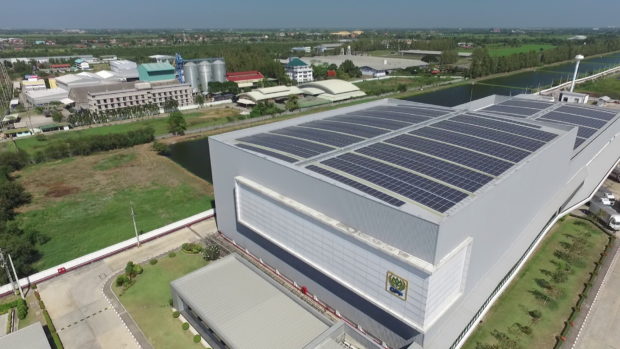
นายวุฒิชัย สิทธิปรีดานันท์ รองกรรมการผู้จัดการอาวุโส ด้านความรับผิดชอบต่อสังคมและการพัฒนาอย่างยั่งยืน ซีพีเอฟ กล่าวว่า ซีพีเอฟนำแนวทางเศรษฐกิจหมุนเวียนมาใช้ทั้งในกระบวนการผลิตอาหารสัตว์ ฟาร์มปศุสัตว์ การผลิตอาหารพร้อมรับประทาน บรรจุภัณฑ์ และสำนักงานของบริษัท และให้ความสำคัญกับการใช้ทรัพยากรพลังงานหมุนเวียน โดยนำทรัพยากรที่ถูกนำไปใช้แล้วให้กลับมาแปรรูปและนำกลับไปใช้ใหม่อีกให้เกิดประสิทธิภาพสูงสุด เช่น การคิดค้นนวัตกรรมสูตรอาหารสัตว์รักษ์โลก ใช้พลังงานหมุนเวียนในฟาร์มปศุสัตว์จากไบโอแก๊สและโซลาร์รูฟทอป การใช้แกลบและขี้เลื่อยเป็นเชื้อเพลิงให้พลังงานในโรงงานแปรรูปอาหาร เป็นต้น ในส่วนของสำนักงานให้มีการแยกขยะ เพื่อนำขยะพลาสติกไปแปรรูปเป็นผลิตภัณฑ์ใหม่ เป็นต้น ซึ่งเป็นหนึ่งใน 3 เสาหลัก ของกลยุทธ์ความรับผิดชอบต่อสังคมสู่ความยั่งยืนของบริษัทฯ คือ อาหารมั่นคง สังคมพึ่งตน และดิน น้ำ ป่า คงอยู่
นอกจากนี้ บริษัทฯ ได้ประกาศนโยบายบรรจุภัณฑ์ที่ยั่งยืน เพื่อให้มั่นใจว่ามีการใช้ทรัพยากรในการผลิตบรรจุภัณฑ์ให้เกิดประโยชน์สูงสุด ลดปัญหาขยะบรรจุภัณฑ์ ควบคู่ไปกับการส่งเสริมการใช้วัสดุที่ช่วยลดผลกระทบต่อสิ่งแวดล้อม เป็นการแก้ปัญหาการใช้ทรัพยากรเกินขนาด โดยมุ่งมั่นออกแบบและพัฒนาบรรจุภัณฑ์อย่างต่อเนื่อง โดยคำนึงถึงการใช้งานตลอดอายุบรรจุภัณฑ์ตั้งแต่การรักษาคุณภาพของผลิตภัณฑ์ การปกป้องผลิตภัณฑ์ระหว่างการขนส่ง การบริโภค รวมทั้งการจัดการบรรจุภัณฑ์หลังการบริโภค ตลอดจนพัฒนาบรรจุภัณฑ์ให้สามารถยดอายุของอาหารให้ยาวนานขึ้น เพื่อช่วยลดการสูญเสียอาหารที่ไม่ถูกบริโภค (food waste) เช่น โครงการปรับรูปแบบบรรจุภัณฑ์ถุงไก่สด ด้วยการเปลี่ยนใช้ถุงพลาสติกชั้นเดียว แทนถุงพลาสติกหลายชั้น ลดขนาดถุงให้เล็กลง ทำให้กล่องกระดาษสำหรับขนส่งเล็กลงและนำกลับมาใช้ใหม่ได้ 100% ซึ่งช่วยลดการใช้กระดาษ 11% ลดใช้พลาสติก 43% และลดต้นทุน 24% ปัจจุบัน สัดส่วนบรรจุภัณฑ์ของซีพีเอฟจำแนกตามวัสดุได้ดังนี้ คือ พลาสติก 74% กระดาษ 24% และ อื่นๆ 2% ตามลำดับ

นายวุฒิชัยกล่าวว่า ซีพีเอฟยังให้ความสำคัญกับอุตสาหกรรมในรูปแบบใหม่ ด้วยการติดตั้งเทคโนโลยีที่เหมาะสมเพื่อเพิ่มประสิทธิภาพ ลดการสูญเสียและลดต้นทุนในกระบวนการผลิตให้ได้สูงสุด การปรับพฤติกรรมของผู้บริโภคด้วยการรณรงค์การแยกขยะและตระหนักถึงการใช้ทรัพยากรอย่างคุ้มค่า และการจัดการขยะให้มีประสิทธิภาพเพิ่มมากขึ้นกว่าเดิม ด้วยการนำทรัพยากรหรือวัตถุดิบบางประเภทที่ถูกใช้ไปแล้ว สามารถนำกลับมาแปรรูป เช่น การนำมูลสัตว์ในฟาร์มสุกร ไปผลิตไบโอแก๊ส เพื่อใช้เป็นพลังงานหมุนเวียนในฟาร์มปศุสัตว์ได้อีก
“ซีพีเอฟกำหนดเรื่องการบรรเทาผลกระทบต่อสิ่งแวดล้อม และการปกป้องความหลากหลายทางชีวภาพ ในเสาหลักด้าน ดิน น้ำ ป่า คงอยู่ โดยการเพิ่มพื้นที่ป่าทั้งป่าบกและป่าเลน ตลอดจนการลดการใช้พลังงานและน้ำในกระบวนการผลิต เพื่อให้มั่นใจว่าธุรกิจ สังคมและสิ่งแวดล้อมจะได้รับผลกระทบน้อยที่สุดทั้งระยะสั้นและระยะยาว” นายวุฒิชัยกล่าวย้ำ

บริษัทฯ ยังส่งเสริมให้คู่ค้าธุรกิจและชุมชน ตระหนักถึงความสำคัญของการอนุรักษ์สิ่งแวดล้อมโดยเริ่มจากตัวเอง ที่บ้านและขยายไปยังชุมชน ด้วยการแยกขยะและการนำกลับมาใช้ซ้ำ (reuse) เพื่อให้เศรษฐกิจหมุนเวียนทำงานได้ครบวงจร จากการผลิต (make) ไปสู่การใช้งาน (use) และนำกลับมาใช้ใหม่ (return) ซึ่งเป็นการส่งเสริมการใช้ทรัพยากรให้เกิดประสิทธิภาพสูงสุดและคุ้มค่ามากที่สุด เพื่อใช้ทรัพยากรใหม่ให้น้อยที่สุด
…
CPF embraces Circular Economy for sustainability-oriented growth
Amid intensifying environmental risks and global temperature, conservationists are crying for “responsibility” from the global community that includes business organizations, shopping complexes and small shops, calling them to unite their powers and create a “balanced and sustainable” planet. In focus is the consumption of exhaustible natural resources like fossil oil, ores and forests. As these resources will not be replenished for hundreds or thousands of years, we need to optimize resources and produce minimum waste.
Today’s questions are how to replenish depleting natural resources and how to deal with waste, especially plastic waste. “Circular Economy” is the answer as it promotes maximum recycling and least waste. The concept is popular in manufacturing industries, whereby materials or raw materials in a product’s lifecycle are recycled or turned to new products to minimize waste that will result in internal and external negative consequences.
Charoen Pokphand Foods PLC (CPF), as a leading integrated agribusiness and food company, realizes the need to balance natural resources and sustainable growth. Circular Economy is embraced in its operations throughout the value chain, practiced side by side with the 11 out of 17 United Nations Sustainable Development Goals (SDGs) as well as the United Nations Global Compact (UN Global Compact).
Mr. Wuthichai Sithipreedanant, CPF’s senior vice president for corporate social responsibility and sustainable development, said that the Circular Economy concept is being applied with the animal feed production, farming, ready-to-eat food production and packaging processes as well as its offices. An equal emphasis is placed on reusable resources. Used resources are reprocessed and reused for maximum efficiency; for example, innovative environmental-friendly feeds, the application of biogas and rooftop solar panels to generate renewable energy for farms, and the use of risk husk and saw dust as the energy source for food processing plants. At office buildings, among several means, plastic waste is sorted for the processing into new products. The approaches are part of CPF’s 3 socially-responsible pillars towards sustainability which are “Food Security, Self-Sufficient Society and “Balance of Nature”.
Along environmental-friendly materials to tackle resource overuse, CPF recently announced its sustainable packaging policy, to assure the maximization of packaging which will lessen waste. Under this policy, CPF is determined to continually design and develop packaging, considering preferred benefits throughout the lifecycle. The packaging is expected to preserve food quality, protect products during transportation, and be properly tackled at the end of its lifecycle. CPF has also developed the packaging that helps prolong food life, to reduce food waste; for instance, fresh chicken bags is now made from single-layered plastic , instead of multi-layered plastic, and come with a smaller size. The paper boxes to deliver the product are hence smaller and 100% reusable. This approach reduces paper by 11%, plastic 43% and cost by 24%. At present, plastic constitutes 74% of CPF’s packaging materials; followed by paper, 24% ; and others, 2%.
Mr. Wuthichai added CPF also emphasizes the application of appropriate technology to boost efficiency, reduce waste and cut production cost; alter consumer behaviors through a campaign promoting waste sorting and awareness in maximizing natural resources; and manage waste more efficiently. Some of used resources or materials are reprocessed; for instance, the increments at swine farms are used to produce biogas, to power the farms with renewable energy.
“CPF is set to alleviate environmental impacts and protect the biodiversity of our 3 pillars – soil, water and forests, through an increase of inland and coastal forest areas and a decrease in energy and water in the production process. We want to ensure the least impacts on our business, society and the environment in both short and long terms,” he said.
CPF also takes a role in promoting the awareness in environmental conservation among business partners and communities. Waste sorting and reuse can start at home, before the practices are replicated in communities. This will complete the Circular Economy cycle, from “Make” and “Use” to “Return”, to ensure the best and most-efficient use of natural resources and the lowest demand for new resources.
